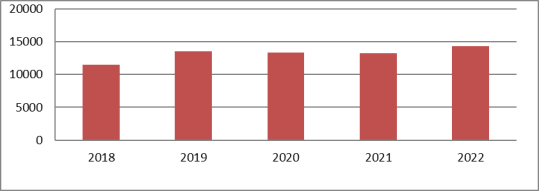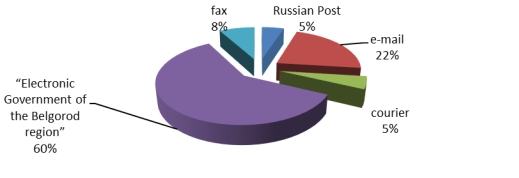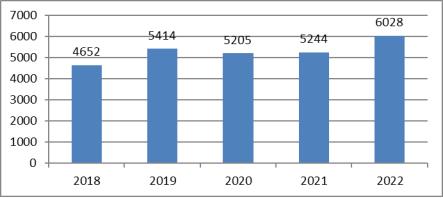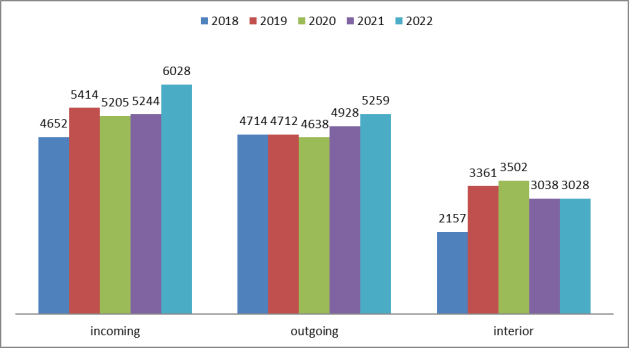In the article, the author tries to describe the procedure for processing incoming documents in the administration of a local government body .
Keywords: document, incoming, administration , registration.
Municipal formation — Grayvoronsky urban district was granted the status of an urban district by the law of the Belgorod region in 2018. [1, p. 52] The administrative center of the Grayvoronsky urban district is Grayvoron.
The structure of local government bodies of the Grayvoronsky urban district consists of: the Council of Deputies of the Grayvoronsky urban district; the chairman of the Council of Deputies of the Grayvoronsky urban district; the administration of the Grayvoronsky urban district; the control and accounting commission of the Grayvoronsky urban district.
The Grayvoronsky urban District Administration is the executive and administrative body of the Grayvoronsky urban District.
All document management operations are carried out by the office management department of the office of the head of the Grayvoronsky urban District administration. The movement of documents is provided by the subsystem for managing internal processes of the regional information and analytical system «Electronic Government of the Belgorod region».
Analyzing the total volume of document circulation over the past 5 years, there is a noticeable tendency for its increase on figure 1

Fig. 1. Dinamika obshchego dokumentooborota za 2018–2022 gg
In the administration of the Grayvoronsky urban district, three document flows can be distinguished: incoming, internal, and outgoing.
The incoming document flow consists of documents received from: the Belgorod Regional Duma, the Governor and heads of the Belgorod Region, the Government of the Belgorod Region, other organizations, and citizens.
The methods of delivery of incoming correspondence to the administration of the Grayvoronsky urban district are: Russian Post, «Electronic Government of the Belgorod region», fax, courier delivery, e-mail. The percentage of delivery methods is shown in figure 2.

Fig. 2. Document delivery methods
The movement of the incoming document flow is organized by the following procedures:
- Acceptance and primary processing of the document (for documents received by Mail from Russia, the correctness of the document's address is checked, the presence of a mark «personally», after opening the envelope, the presence of all attachments specified in the text of the cover letter, in the absence of any document, an appropriate act is drawn up).
- Creation of an electronic image of the document (for documents received on paper).
- Preliminary examination of the document by the office management department.
- Registration.
- Consideration by the head of the city district administration or another head.
- Transfer to execution in accordance with the resolution.
- Setting up control over the execution of the document.
- Execution.
- Removal from control and sending the document to the case.
All the documents that have been dropped are registered in the office management department through the «Electronic Government of the Belgorod region» once: upon receipt of the document before 16:00 — on the same day, upon receipt after 16:00 — on the next business day.
The purpose of registration is to give the document legal force, to ensure accounting, control and search of documents. Registration allows you to:
– to confirm the receipt of the document;
– create a registration and reference device that can be used for informational purposes;
– to monitor the execution of the document;
– to give qualitative and quantitative characteristics of documents [4, p. 130].
If the received document is not registered, the organization does not assume responsibility for it, since it is not possible to confirm the fact of receipt [3, p. 44].
On the paper version of the received document, a stamp is affixed in the lower right corner, in which the registration number and date of registration are handwritten. The registration numbers of incoming documents are generated according to the following requirements:
– when registering incoming documents from legal entities: the index of the municipality assigned in the Administration of the Governor of the Belgorod region, the «dash» sign, the index assigned to the head in the administration of the city district, the «dash» sign, the index of the type of document assigned according to the nomenclature of cases in the administration of the city district, through the «slash» sign, the serial number in within a calendar year (for example, 46–01–04/1325);
– when registering incoming appeals from citizens: the first letter of the applicant's surname, through the «dash» sign, the serial number of the appeal within the calendar year (for example, G-145).
For documents received on paper, an electronic image is created by scanning for placement in the «Electronic Government of the Belgorod region» (except for documents containing personal data, documents marked for official use, they are transmitted only on paper under signature in a printed registration (depersonalized) card.
Considering that the originals of incoming documents must be subject to centralized storage according to the requirements of the nomenclature of cases, they are marked «Subject to return» and the executors are obliged to return the original document upon completion of the execution of the document [4, p. 130].
When registering incoming documents in the «Electronic Government of the Belgorod region», the following information is filled in: incoming number; unit code; case code; registration date; correspondent; who signed; outgoing document number from the correspondent; date of outgoing document from the correspondent; type of document flow; delivery method; summary; note; resolution; call/request; frequency of execution, year.
All received documents undergo a preliminary review procedure in the office management department of the head of administration to identify documents that require mandatory consideration by the head or addressed to other heads of administration.
After reviewing the incoming document by the head of the administration, his deputies, the executive is determined in the resolution, the instructions themselves are formulated within the framework of the execution of this document, the date and signature of the head. The resolution is drawn up on a special sheet or on the document itself in the upper right corner or on any free space if there is none in the upper right corner. Next, the document is translated for execution by creating an electronic resolution in the document registration card.
The statistics of incoming documents are shown in figure 3

Fig. 3. Volume of incoming document flow
The execution of the document involves the collection of necessary information, the preparation of a draft document, its approval, signing and preparation for shipment.
If you imagine the volume of document flow over the past five years in terms of document flows, you can see which flows are increasing document flow. As follows from the diagram in figure 4, the increase is mainly due to an increase in incoming and internal document flow.

Fig. 4. Dynamics of document flow by document flow
Control over the execution of incoming documents is also carried out in the «Electronic Government of the Belgorod region», where information is entered on the date of control, the deadline for execution and performers, the frequency of execution, if available.
The document is removed from control after the submission of the reporting document. The document is considered executed if all the issues raised in the order or requested by the correspondent have been resolved.
References:
- The Charter of the Grayvoronsky urban district (approved by the decision of the Council of Deputies of the Grayvoronsky urban District dated 11/08/2018 No. 37).– Grayvoron, 2018. — 52 p.
- Petrova Yu.A. Secretarial business. The desk book of the secretary-referent. — M.: Omega-L, 2008, 318 p.
- Secretarial work (samples of documents, organization and technology of work): study.-practice. Manual / V. V. Galakhov, I. K. Korneev [et al.]; edited by I. V. Korneev — M.: TK Velbi, Prospekt Publishing House, 2007. 608 p.
- Office work: Samples, documents. Organization and technology of work. More than 120 documents. 2nd ed., reprint. And additional / V. V. Galakhov, I. K. Korneev et al.: edited by I. K. Korneev, V. A. Kudryaev. — Moscow: TK Welby, Prospekt Publishing House, 2005, 456 p.







